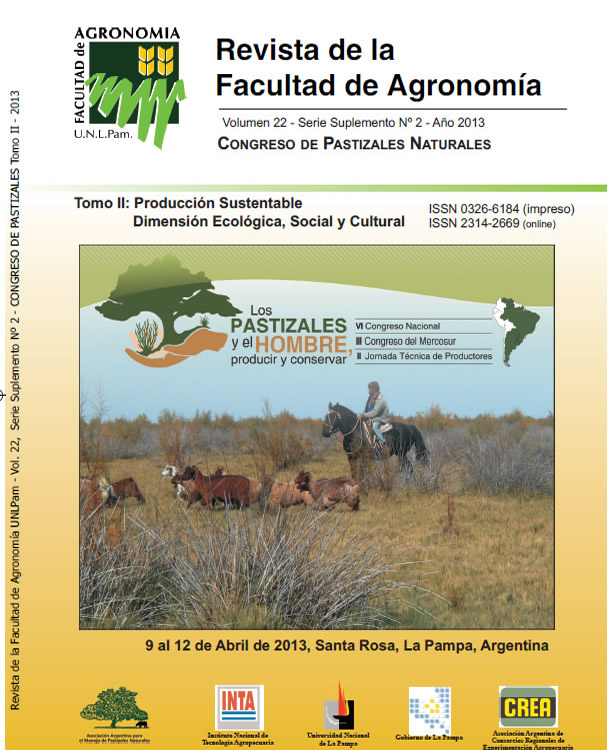Diversity evaluation of a natural rangeland under different disturbance regimes
Keywords:
Fire, Grazing, Richness, Shannon indexAbstract
This study was conducted to evaluate the effect of management on species diversity in a natural grassland of the experimental area of the Rangeland Ecology Laboratory (LEPAN), Universidade Federal de Santa Maria/Rio Grande do Sul, Brazil which has been submitted to different fire and grazing regimes along 16 years. Treatments consisted of the combination of burning and grazing factors in convex and concave slope positions in a completely randomized design. Grazing was rotational with rest intervals calculated by accumulated thermal time (760 degree days) required for the expansion of four leaves of Paspalum notatum and Andropogon lateralis. Botanical composition was determined using the BOTANAL method from 2006 to 2011. Data on number (nº) of species and Shannon index were analyzed by randomization tests in an analysis of variance using MULTIV software. Grazing had the strongest (P =0.036) influence on Shannon index and number of species. There was an interaction between grazing and relief position (P =0.052) and grazing and burning (P =0.07). There was significant difference for grazing in concave slope and for grazing on burned areas. We can conclude that management history, as well as type of disturbance affects richness and diversity of species.
Downloads
References
Nabinger C., E.T. Ferreira & A.K. Freitas. 2009. Produção Animal com base no campo nativo: aplicações de resultados de pesquisa. In: Campos Sulinos: Conservação e Uso Sustentável da Biodiversidade (V.D. Pillar, S.C. Müller, Z.M.S., Castilhos & A.V.A. Jacques eds). Ministério do Meio Ambiente, Brasília. pp. 175-198.
Pillar V.D. 1994. Interações entre organismos, fatores de ambiente e formação de comunidades vegetais. UFRGS, Departamento de Botânica. Porto Alegre.
Tothill J.C., J.N.G. Hargreaves, R.M. Jones & C.K. Mcdonald. 1992. BOTANAL - A comprehensive sampling and computing procedure for estimating pasture yield and composition. 1. Field sampling. Trop. Agric. Tech. Memo. 78:24.
Downloads
Published
Issue
Section
License
La Editorial de la Universidad Nacional de La Pampa (EdUNLPam) exigirá a los/as autores/as la firma del siguiente documento:
La EdUNLPam lleva a cabo la publicación del artículo: (Título del Artículo) en SEMIÁRIDA Rev.Fac.Agron UNLPam ISSN 2362-4337 (impresa) ISSN 2408-4077 (en línea), del cual el/los abajo firmantes son autores de una o más partes. En el mismo acto, el/los autores entregan exclusivamente a la EdUNLPam todos sus derechos protegidos por las leyes de propiedad intelectual que rigen en la Argentina para reproducir, publicar, editar, fijar, comunicar y transmitir públicamente en cualquier formato o medio impreso o electrónico, inclusive internet, el artículo enviado a publicación e incluirlo en índices o bases de datos nacionales e internacionales. A cambio, la EdUNLPam entrega a los autores la autorización para la publicación o reimpresión con ines académicos y educativos en cualquier libro o medio de divulgación, con la sola obligación de citar el artículo original publicado en la EdUNLPam. Cada autor acuerda en que el material provisto a la EdUNLPam es un trabajo original, que no ha sido impreso o publicado en cualquier otro medio con anterioridad y que no vulnera derechos de terceros. El Primer autor tendrá la posibilidad de leer y corregir el artículo ya editado como “prueba de galera”, pero si el autor no devolviera esas correcciones de la prueba de galera dentro del tiempo especificado, el proceso de producción y publicación podrá proseguir sin la aprobación del autor. El/los autor/es no recibirán compensación monetaria de la EdUNLPam por el uso del material contenido en este artículo y asumen la responsabilidad de las opiniones vertidas en él.






.png)



22.png)



.jpg)




.jpg)
